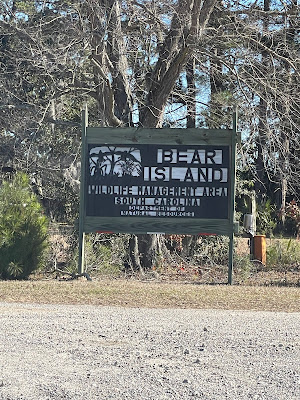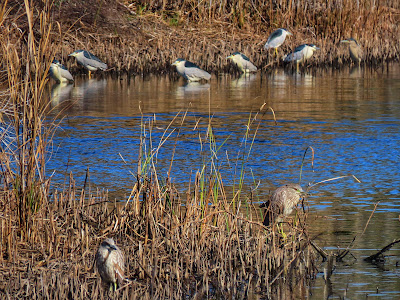I was eager to get in an early 2025 nature outing so on Jan. 9 I cleared my schedule and headed south down to the ACE Basin.
It was clear cold day with temperatures in the 39-41 degrees range. I felt it in my hands while walking around looking for birds to photograph.
I knew the Bear Island Wildlife Management Area might be closed, and it was for periodic hunting.
But I also knew that I could still check out Mary’s House Pond, which is accessible after parking in the entrance area.
Having been to Bear Island many times (see this post when we took bicycles out there!), the large pond attracts many birds, especially migratory ones in the winter.
I would not be disappointed! Tundra Swans were the stars of the show.
Tundras are North America’s most common swan but you don’t see them too often in the S.C. Lowcountry. They breed in Canada and Alaska and migrate to the Pacific and Atlantic coasts during the winter.
Here at Bear Island is the only place I have seen this big beauty.
The Swans feed by sticking their long necks under the water.
The Swan in the front of this photo has company. That’s a Northern Shoveler floating left to right and behind the Swan looking my way is an American Wigeon. Both are also winter visitors from faraway Alaska and Canada.
The Northern Shoveler and American Wigeon are dabbling ducks that seek their food by sticking their heads straight down in the water while their backsides are up in the air. Diving ducks will completely submerge in the water. The Pied-billed Grebe, shown later in this post, is a type of diving duck.
Three Northern Shovelers and an American Wigeon. That’s a female Shoveler by her beau. The Northern Shoveler is described as a medium-sized dabbling duck with a uniquely large spoon (or shovel) shaped bill.
The American Wigeon is also called “baldplate” for its white head stripe.
This image is not as sharp as I would have liked but it shows the duck density, a mix of American Wigeons and Northern Shovelers.
OK let’s go the other way now…
While I was watching all the activity in the pond this small bird appeared in a shrub to my left. This is a Ruby-crowned Kinglet. I have had many visits to my backyard feeders by this bird in recent weeks. I hope to see one with the redhead feathers showing. That is the origin of the ruby name.
When I first arrived at Bear Island I spotted this shorebird in other waters opposite from Mary’s House Pond. This is the Greater Yellowlegs.
Now you see why it has this name. The species is also migratory though of late the weather here hasn’t been on the warm side.
I’m told the main part of the Bear Island WMA and its 12,153 acres, will open Feb. 9. It’s great that even when closed for hunting I still had excellent views of some of its waters busy with birds.
A good thing about Bear Island is its proximity to another vast wildlife management area. Bear Island is located about 13 miles from Highway 17 off Bennett’s Point Road.
Drive several miles back toward Highway 17 and you see this sign and follow it to enter the Donnelley Wildlife Managementg Area, which has more than 8,000 acres.
Donnelley is an ideal companion to Bear, offering a different layout and look.
Fortunately for me, the birding was also bountiful at Donnelley.
Look for water and that’s where the birds may be. The waterways here, like at Bear Island, are former rice fields part of plantations where enslaved Africans would toil making fortunes for their masters.
Spotting this pond from my car I parked and walked through trees to the bank. Here I was closer to the action than at Bear Island so my photographs are closer.
There were Little Blue Herons all over, the most I’ve ever seen together. There are five in this shot. I can’t positively identify the two white birds with their heads in the water. They could be juveniles of these species (keep reading to learn about this unique characteristic).
More Little Blue Herons.
A White Ibis with three Little Blues. A group of Herons has different collective names such as siege, herd, battery or hedge.
A mature Little Blue Heron has a striking look with its slate-gray body and blueish red neck and head. Its bill is white with a black tip.
This is an immature LBH. Yes, they are born all white and eventually transform to the dark feathers. A key identification is the black tip on the bill. Otherwise, it could be mistaken for an Egret.
Two matures in the foreground and a youngster in the background.
In flight…
The adults have a very distinctive look. Audubon calls them “chunky” and “unmistakable” with black cap and back with gray wings.
Check out this post I did about Black-crowned Night Herons in January 2011. They are featured in my book, “The Birds of Magnolia Cemetery: Charleston’s Secret Bird Sanctuary.” I published a second edition of my 2011 book this past summer.
In the weeds with a Snowy Egret (front right and in the back) and American White Ibis with their long orange down-curved bills.
When a bunch of Ibis are standing it’s a colony.
Note the small bird floating in the pond (right). I did not notice it until downloading my photographs. This is a female Hooded Merganser, a lovely species called Hoodies for short.
A pair of Pied-billed Grebes. These are diving ducks that will go completely underwater to grab a meal or to evade a nearby photograph.
This is another Gull spotted on a post earlier at the Bear Island WMA pond. My bird ID app says it’s a Laughing Gull. It does though resemble the Ring-billed Gull.
These are Forster’s Terns flying in a corner of the large Donnelley pond. Note the specks of floating birds. These are Hooded Mergansers, which apparently have no collective name.
This is one of the many wooden trunks that control the flow of water in and out of the former rice fields. It’s old technology that still does the job today.
I spent about 2.5 hours on the ground between the two WMAs, Bear Island then Donnelley. From my home to the Highway 17 turn to these wonderful nature preserves took on this day exactly one hour. It was another 15-20 minutes to reach the Bear Island entrance.
This visit I purchased this ceramic owl. It is in perfect condition and I thought the $25 price tag was reasonable. It is now on my front porch on a table.
Before stopping at the restaurant and antique shop I spent a few minutes photographing this old, abandoned church. It is right here on Highway 17 in the small town of Jacksonboro.




























































No comments:
Post a Comment